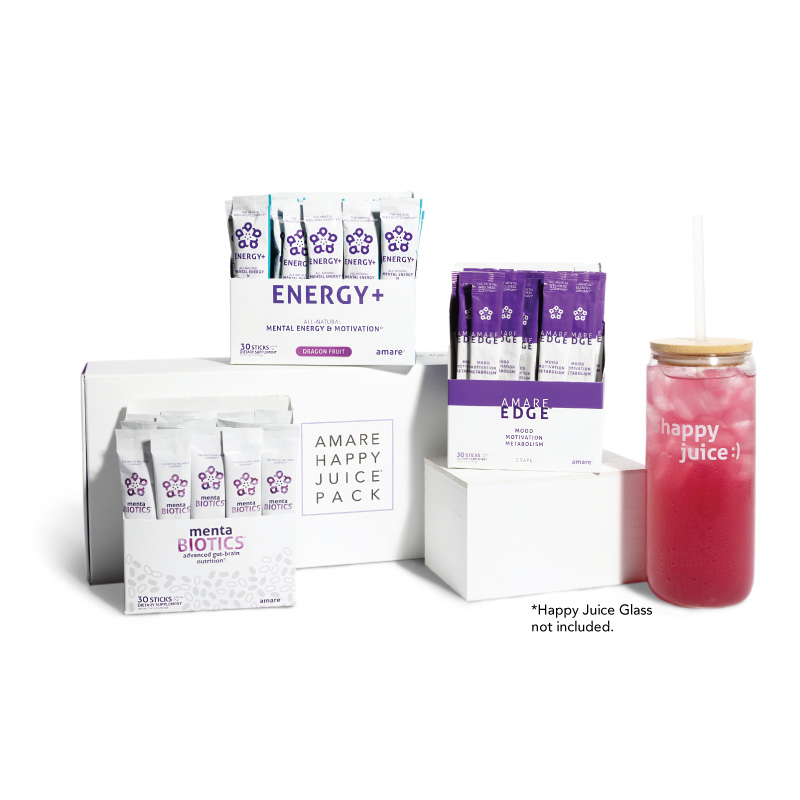Listen on: Apple Podcasts | Spotify
Over the past decade, research has shown what the Finns and other Scandinavians have known for millennia. The sauna is good for you!
I’ve outlined seven reasons you should sauna, and described how to sauna to get the most health benefit. I also included some of the most common questions people ask at the end.

Feel Better Fast. Guaranteed.
Energy+, EDGE, and MentaBiotics make up the Happy Juice supplement stack, with ingredients clinically proven to:
- decrease anxiousness scores by 55%
- decrease irritability scores by 60%
- decrease fatigue by 64%
- decrease anger 54%
- decrease tension by 45%
- decrease confusion by 43%
- decrease overall distress by 49%
- increase good bacteria by 70%
- decrease negative mood by 105%
- increase positive mood by 211%
How to Take a Sauna
Finnish saunas are hot. For those who’ve never experienced a sauna, the first few times will feel almost unbearable. But like anything else in life, you eventually adapt to the stress. And that’s when you start to experience the health benefits of the sauna.
- Set the temperature between 176° F (80° C) and 212° F (100° C). The hotter, the better. As you adapt to the lower end of this temperature range, work your way up, toward 212°.
- After acclimating to the heat, toss a scoop of water on the rocks. If you use a sauna in a commercial space, this may not be allowed. Tossing the water onto the hot stones creates a quick blast of steam, which makes the temperature feel much higher. As the steam hits your skin, it feels like you’re getting hit with thousands of tiny pinpricks.
- Gently beat your skin with silver birch branches. This adds to the intensity of the sauna and may enhance the detoxification benefits.
- Stay in the sauna for 15 minutes or more. You may need to work up to this duration if you’ve never used a sauna before.
- Step out of the sauna, wipe off your sweat, and cool down. Wiping off the sweat helps ensure toxins you’ve released won’t re-enter your skin as you cool off. Drink plenty of water to help replace what you’ve lost through perspiration. If your sauna happens to be near a lake, jump in. If not, you could take a quick, cool shower.
- Re-enter the sauna for another 15+ minutes. You’ll notice that the next time, you sweat sooner than the time before. If you have the time, you can do another cool-down session followed by another sauna session. Traditionally, people took up to two hours for their sauna practices.
- Take a cold shower and cool down completely. If you do not cool down properly, you’ll continue to sweat, which lowers blood volume, raises hematocrit and cortisol and thickens your blood. You may also feel fatigued or experience chest or joint pain, bruising, or even bloody stools.
Pro Tip: Use Essential Oils In The Sauna
Sipping water with peppermint essential oil may help you last longer, as it has a cooling effect on the body.
7 Sauna Health Benefits
A sauna is enjoyable, but not necessarily comfortable. It’s the discomfort that causes the effects on your body, which is known as heat stress. Your body perceives the extreme heat as a threat and reacts accordingly.
You feel surprised by the initial blast of heat when you walk in the door, but it’s five to fifteen minutes later, when your core temperature begins to rise, that alarms start going off in your body.
Blood flows away from your core and out to your skin, and blood vessels dilate, making it easier to get blood, and the heat it holds onto, out to your skin where the heat passes to the environment. Of course, it doesn’t work so well, since it’s hotter in the sauna than it is in your body.
You begin to sweat as another means of cooling the body. Your heart beats faster and pumps more blood with each stroke. You secrete stress-related hormones and neurotransmitters, and your brain starts talking you into stepping out of the sauna.
But if you wait a little longer, and get past the point of discomfort, you’ll gain the health benefits described below. And with each sauna session, you learn to handle the heat a little better than before, allowing you to last longer, or handle it hotter. You adapt to the stress response as you adapt to any other stress.
1. Increases growth hormone and norepinephrine
Growth hormone-releasing hormone (the hormone that tells your pituitary to release growth hormone) can rise to four times its normal level, while growth hormone itself can increase two to five times normal. The rise in growth hormone may enhance fat metabolism, speed tissue recovery, and aid in muscle growth.
Norepinephrine increases by two to four times normal levels, but studies on epinephrine show it doesn’t always rise. Both neurotransmitters usually increase in response to stress.
It can take up to 24 hours for some hormones to return to baseline.
2. Enhances detoxification
You release toxins through your breath, bladders, bowels, and sweat. However, sweat seems to excrete toxins better than any other means. Unfortunately, in our temperature-controlled lifestyles, few of us sweat often.
Sweat aids in the excretion of heavy metals, including:
- aluminum
- arsenic
- bismuth
- cadmium
- lead
- mercury
- uranium
Perspiration also aids in the excretion of endocrine disruptors like bisphenol A (BPA).
Your body stores toxins in fat cells as a way to keep them away from other tissues. As you shrink your fat cells, you release those toxins back into your circulation. If you’re following a weight loss program, a sauna can help you release those toxins for good.
To assist with the detoxification process:
- Stay hydrated.
- Increase your fiber intake.
- Eat a higher-protein diet.
- Support the process with supplements such as n-acetyl-cysteine (NAC), berberine, curcumin, and milk thistle.
Detoxification for Police Officers
Repeated exposure to methamphetamines during drug busts can cause severe and debilitating effects for police officers. A 2012 paper outlined the impact of a sauna-based detox program for the officers.
Following the treatment, the researchers concluded, “sauna and nutritional therapy may alleviate chronic symptoms appearing after chemical exposures associated with methamphetamine-related law enforcement activities.”
Sleep significantly improved as well. Before the treatment, officers averaged 5.8 hours of sleep. Following the treatment, they averaged 7.6 hours. Improved sleep alone is enough to impact their health dramatically!
If a sauna is that powerful for something like meth, imagine its impact on the hundreds of other toxins you’re exposed to every day.
To ensure you remove the toxins, wipe the sweat off your body regularly while using the sauna.
3. Speeds recovery from exercise and physical stress.
Since the sauna raises growth hormone, it’s no surprise that it improves recovery rates from exercise.
Sauna sessions also reduce oxidative stress after exercise. The more intense your training session, the more free radicals you create. The sauna helps you combat those free radicals by supporting your body’s antioxidant system.
Of course, you should still consume plenty of antioxidants through diet and supplements, like a high-quality multivitamin.
4. Increases your pain and heat thresholds
Have you ever noticed how hot a 50°F spring day feels after bitter and snowy winter, but how cold a 50° F day feels by late-summer? Your body adapts to temperature changes the same way it adapts to almost anything else.
By consistently exposing it to extreme temperatures, you get better at regulating your temperature in any environment. You also get better at handling pain.
I wasn’t exaggerating when I wrote that the steam from throwing water on the stones feels like a thousand pinpricks. The first time you feel it, it might be almost unbearable. Over time, you adapt. Your perception of the pain changes.
As you learn to handle higher temperatures in the sauna, you can handle higher outdoor temperatures without getting dizzy or disoriented.
5. Reduces pain and inflammation
Systemic inflammation increases the risk of cardiovascular disease, and more recently, seems to increase the risk of severe COVID-19 infection. According to research, the more often people take a sauna, the lower their C-reactive protein levels. C-reactive protein is the primary marker of systemic inflammation.
Those who use the sauna regularly have lower rates of heart disease and high blood pressure. Cardiac output increases during a sauna session in a similar way as it does during exercise. While I wouldn’t consider the sauna to be the equivalent of an intense training session, it does improve cardiovascular health to a small degree. This would be especially beneficial for those who are overweight or otherwise unable to exercise.
Inflammation also contributes to other degenerative diseases like Alzheimer’s disease. Research shows the sauna may slow the progression of this disease.
While I always encourage people to exercise, which also lowers inflammation, many people are unable to exercise due to their state of health. A good first step might be to use the sauna regularly, as it requires no physical activity. Then, once their health improves, begin strength training.
The sauna may also decrease chronic pain for those with arthritis and reduces the severity of tension headaches in headache sufferers.
As a short-term stressor, saunas stimulate white blood cell production, which enhances your immune system. Those who sauna regularly have a lower occurrence of infections, especially respiratory-related infections.
6. Lowers stress levels
While many of the health benefits of the sauna are physical, sauna bathing also improves mental well-being.
Sauna bathing has numerous health benefits including the promotion of mental well-being and relaxation; however, its association with mental disorders is unknown. In this new study, frequent sauna bathing was strongly associated with a reduced risk of psychotic disorders. These new findings add to emerging evidence that frequent sauna therapy could reduce the risk of several acute and chronic health conditions.
Laukkanen T, et al.
Of course, the sauna forces you to step away from technology, but it also has a metabolic effect that leads to lower stress levels.
Research shows that cortisol levels drop 10-40%. Cortisol is your primary stress hormone. Add that to the fact that inflammation and oxidation levels drop, and it’s no surprise that mental wellbeing improves with sauna usage.
7. Boosts immune system
People have used heat therapy for thousands of years to deal with respiratory illness and other sicknesses. Breathing hot, humid air into your sinuses enhances your immune function.
Inhalation of hot air supports the immune system’s first line of defence by direct inhibition or deactivation of virions in the upper airways where they first lodge. Inhalation of hot humid air also supports muco-ciliary clearance, which can be further enhanced by inhalation of steam. Heat applied to the whole body further supports the immune system’s second line of defence by inducing heat-stress that mimics the effects of fever.
Cohen M.
Heat stress also reduces sinus congestion and stimulates white blood cell production. Those who sauna regularly have a lower occurrence of infections, especially respiratory-related infections.
Unfortunately, with the restrictions surrounding COVID-19, most health clubs’ saunas and steam rooms remain closed. It’s ironic that one of the most important areas of a health club for combating the coronavirus (and other pathogens) remains closed out of fear of spreading the virus.
Frequently Asked Questions About the Sauna
What if I have trouble sweating?
I first observed this issue when I was training novice clients. Part-way through some workouts, they’d get pale, and their skin would feel cold and clammy. I’d have them walk on a treadmill for a few minutes, and all-of-a-sudden, sweat would pour out of them. It was as though they had a delay in regulating their temperature.
After they’d start sweating, they’d feel normal, and we’d continue our training session. If you can relate, a sauna is a great way to help you learn to sweat again. You’ll need to push past the point of discomfort. Over time, you may notice you sweat easier doing other activities and won’t fatigue as quickly.
Which is better, the sauna or the steam room?
Steam rooms maintain a lower temperature, but higher humidity. Because of the high humidity, you can’t cool yourself by sweating in the same way you can in the sauna. The sweat doesn’t evaporate. As a result, you might trigger some of the heat-stress health benefits sooner in the steam room.
However, the steam room may not stimulate the same immune-supporting benefits due to the lower temperature. Because you won’t sweat as easily in a steam room, it may not offer the same detoxifying effects.
If you like the heat of the dry sauna, and also want the humidity of a steam room, toss water on the rocks of your sauna stove and turn it into a steam sauna.
Should you use the sauna if you have adrenal fatigue?
As I mentioned above, research shows the sauna lowers cortisol levels by 10-40%. However, those with adrenal fatigue already have low cortisol from dealing with high cortisol for too long.
Also, they often experience low blood pressure and a lower level of resilience to stress, including heat stress.
If you have adrenal fatigue, start with short periods in the sauna and work your way up. For example, start with five minutes two to three times a week, and add a minute each week until you can handle 15 minutes. Then, go to a couple of sauna sessions with a brief cooling-off period in between.
Is a traditional sauna better than an infrared sauna?
Most of the research on sauna bathing is based on the traditional form. However, I wouldn’t dismiss the benefits of infrared. The infrared sauna maintains a lower temperature because the light helps the heat penetrate your body more deeply. Because of the lower temperatures, it may not have the same benefits for respiratory health or fighting viruses, but it does seem to offer many other health benefits.
Summary
Start with taking a sauna a few times per week for three months.
If you combine it with a good strength training workout, take your sauna after your training session.
I prefer to take a sauna on my off-days from exercise. As you increase your duration, you might decrease your frequency.
Stick with it for three months, and you’ll see why the Finns and other Scandinavians love the sauna so much. Other than getting enough sleep, I don’t know of another activity that offers so many health benefits for sitting in place, not doing anything.

Feel Better Fast. Guaranteed.
Energy+, EDGE, and MentaBiotics make up the Happy Juice supplement stack, with ingredients clinically proven to:
- decrease anxiousness scores by 55%
- decrease irritability scores by 60%
- decrease fatigue by 64%
- decrease anger 54%
- decrease tension by 45%
- decrease confusion by 43%
- decrease overall distress by 49%
- increase good bacteria by 70%
- decrease negative mood by 105%
- increase positive mood by 211%



